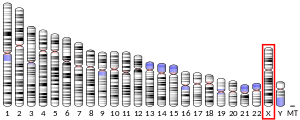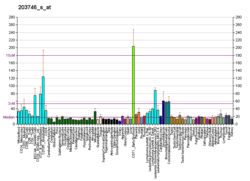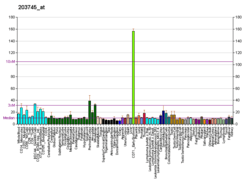HCCS (gene)
Cytochrome c-type heme lyase is an enzyme that in humans is encoded by the HCCS gene on chromosome X.[5]
| HCCS | |||||||||||||||||||||||||
|---|---|---|---|---|---|---|---|---|---|---|---|---|---|---|---|---|---|---|---|---|---|---|---|---|---|
| Identifiers | |||||||||||||||||||||||||
| Aliases | HCCS, CCHL, MCOPS7, MLS, LSDMCA1, holocytochrome c synthase | ||||||||||||||||||||||||
| External IDs | OMIM: 300056 MGI: 106911 HomoloGene: 3897 GeneCards: HCCS | ||||||||||||||||||||||||
| |||||||||||||||||||||||||
| |||||||||||||||||||||||||
| |||||||||||||||||||||||||
| |||||||||||||||||||||||||
| Orthologs | |||||||||||||||||||||||||
| Species | Human | Mouse | |||||||||||||||||||||||
| Entrez | |||||||||||||||||||||||||
| Ensembl | |||||||||||||||||||||||||
| UniProt | |||||||||||||||||||||||||
| RefSeq (mRNA) | |||||||||||||||||||||||||
| RefSeq (protein) | |||||||||||||||||||||||||
| Location (UCSC) | Chr X: 11.11 – 11.12 Mb | Chr X: 169.25 – 169.32 Mb | |||||||||||||||||||||||
| PubMed search | [3] | [4] | |||||||||||||||||||||||
| Wikidata | |||||||||||||||||||||||||
| |||||||||||||||||||||||||
Structure
The HCCS gene is located on the Xp22 region of chromosome X and encodes a protein that is ~30 kDa in size. The HCCS protein is localized to the inner mitochondrial membrane and is expressed in multiple tissue including prominently in the cardiovascular system and the central nervous system.[6]
Function
The HCCS protein functions as a lyase to covalently attach the heme group to the apoprotein of cytochrome c on the inner mitochondrial membrane of the mitochondrion.[7] The heme group is required for cytochrome c to transport electrons from complex III to complex IV of the electron transport chain during respiration. Heme attachment to cytochrome c takes place in the intermembrane space and requires conserved heme-interacting residues on HCCS on one of the two heme-binding domains on HCCS, including His154.[8] The HCCS protein may function to regulate mitochondrial lipid and total mitochondrial mass in response to mitochondrial dysfunctions.[9]
Clinical Significance
Mutations in the MCCS gene cause Microphthalmia with linear skin defects (MLS) syndrome,[10] also known as MIDAS syndrome, microphthalmia, syndromic 7 (MCOPS7), or microphthalmia, dermal aplasia, and sclerocornea.[11][12] MLS is a rare X-linked dominant male-lethal disease characterized by unilateral or bilateral microphthalmia and linear skin defects in affected females, and in utero lethality for affected males.[11]
References
- GRCh38: Ensembl release 89: ENSG00000004961 - Ensembl, May 2017
- GRCm38: Ensembl release 89: ENSMUSG00000031352 - Ensembl, May 2017
- "Human PubMed Reference:". National Center for Biotechnology Information, U.S. National Library of Medicine.
- "Mouse PubMed Reference:". National Center for Biotechnology Information, U.S. National Library of Medicine.
- "Entrez Gene: HCCS holocytochrome c synthase (cytochrome c heme-lyase)".
- http://www.ebi.ac.uk/gxa/genes/ENSG00000004961
- Babbitt SE, San Francisco B, Mendez DL, Lukat-Rodgers GS, Rodgers KR, Bretsnyder EC, Kranz RG (2014). "Mechanisms of mitochondrial holocytochrome c synthase and the key roles played by cysteines and histidine of the heme attachment site, Cys-XX-Cys-His". J. Biol. Chem. 289 (42): 28795–807. doi:10.1074/jbc.M114.593509. PMC 4200240. PMID 25170082.
- Babbitt SE, San Francisco B, Bretsnyder EC, Kranz RG (2014). "Conserved residues of the human mitochondrial holocytochrome c synthase mediate interactions with heme". Biochemistry. 53 (32): 5261–71. doi:10.1021/bi500704p. PMC 4139152. PMID 25054239.
- Nakashima-Kamimura N, Asoh S, Ishibashi Y, Mukai Y, Shidara Y, Oda H, Munakata K, Goto Y, Ohta S (2005). "MIDAS/GPP34, a nuclear gene product, regulates total mitochondrial mass in response to mitochondrial dysfunction". J. Cell Sci. 118 (Pt 22): 5357–67. doi:10.1242/jcs.02645. PMID 16263763.
- Wimplinger I, Morleo M, Rosenberger G, Iaconis D, Orth U, Meinecke P, Lerer I, Ballabio A, Gal A, Franco B, Kutsche K (2006). "Mutations of the mitochondrial holocytochrome c-type synthase in X-linked dominant microphthalmia with linear skin defects syndrome". Am. J. Hum. Genet. 79 (5): 878–89. doi:10.1086/508474. PMC 1698567. PMID 17033964.
- http://www.omim.org/entry/309801
- Wimplinger I, Shaw GM, Kutsche K (2007). "HCCS loss-of-function missense mutation in a female with bilateral microphthalmia and sclerocornea: a novel gene for severe ocular malformations?". Mol. Vis. 13: 1475–82. PMID 17893649.
Further reading
- Wapenaar MC, Bassi MT, Schaefer L, et al. (1993). "The genes for X-linked ocular albinism (OA1) and microphthalmia with linear skin defects (MLS): cloning and characterization of the critical regions". Hum. Mol. Genet. 2 (7): 947–52. doi:10.1093/hmg/2.7.947. PMID 8364577.
- Schaefer L, Ballabio A, Zoghbi HY (1997). "Cloning and characterization of a putative human holocytochrome c-type synthetase gene (HCCS) isolated from the critical region for microphthalmia with linear skin defects (MLS)". Genomics. 34 (2): 166–72. doi:10.1006/geno.1996.0261. PMID 8661044.
- Van den Veyver IB, Subramanian S, Zoghbi HY (1998). "Genomic structure of a human holocytochrome c-type synthetase gene in Xp22.3 and mutation analysis in patients with Rett syndrome". Am. J. Med. Genet. 78 (2): 179–81. doi:10.1002/(SICI)1096-8628(19980630)78:2<179::AID-AJMG17>3.0.CO;2-K. PMID 9674913.
- Schwarz QP, Cox TC (2002). "Complementation of a yeast CYC3 deficiency identifies an X-linked mammalian activator of apocytochrome c". Genomics. 79 (1): 51–7. doi:10.1006/geno.2001.6677. PMID 11827457.
- Prakash SK, Cormier TA, McCall AE, et al. (2003). "Loss of holocytochrome c-type synthetase causes the male lethality of X-linked dominant microphthalmia with linear skin defects (MLS) syndrome". Hum. Mol. Genet. 11 (25): 3237–48. doi:10.1093/hmg/11.25.3237. PMID 12444108.
- Strausberg RL, Feingold EA, Grouse LH, et al. (2003). "Generation and initial analysis of more than 15,000 full-length human and mouse cDNA sequences". Proc. Natl. Acad. Sci. U.S.A. 99 (26): 16899–903. doi:10.1073/pnas.242603899. PMC 139241. PMID 12477932.
- Ota T, Suzuki Y, Nishikawa T, et al. (2004). "Complete sequencing and characterization of 21,243 full-length human cDNAs". Nat. Genet. 36 (1): 40–5. doi:10.1038/ng1285. PMID 14702039.
- Gerhard DS, Wagner L, Feingold EA, et al. (2004). "The status, quality, and expansion of the NIH full-length cDNA project: the Mammalian Gene Collection (MGC)". Genome Res. 14 (10B): 2121–7. doi:10.1101/gr.2596504. PMC 528928. PMID 15489334.
- Nakashima-Kamimura N, Asoh S, Ishibashi Y, et al. (2006). "MIDAS/GPP34, a nuclear gene product, regulates total mitochondrial mass in response to mitochondrial dysfunction". J. Cell Sci. 118 (Pt 22): 5357–67. doi:10.1242/jcs.02645. PMID 16263763.
- Wimplinger I, Morleo M, Rosenberger G, et al. (2006). "Mutations of the mitochondrial holocytochrome c-type synthase in X-linked dominant microphthalmia with linear skin defects syndrome". Am. J. Hum. Genet. 79 (5): 878–89. doi:10.1086/508474. PMC 1698567. PMID 17033964.
- Wimplinger I, Shaw GM, Kutsche K (2007). "HCCS loss-of-function missense mutation in a female with bilateral microphthalmia and sclerocornea: a novel gene for severe ocular malformations?". Mol. Vis. 13: 1475–82. PMID 17893649.





